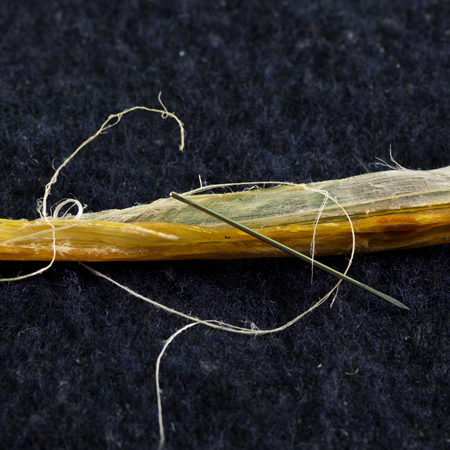In the Lemhi River Valley, Clark is well received by the Lemhi Shoshones and enlists Toby as a guide. Together, they head down the valley and Clark sees his first Pacific salmon. They camp near Withington Creek.
At Fortunate Camp at the end of the Beaverhead River, Lewis has a cache dug. He describes Shoshone clothes and tippets and has pack saddles and harnesses made.
In Washington City, house master Etienne Lemaire writes a letter to President Jefferson regarding the specimens that have arrived from Fort Mandan.
Lemhi Valley at Baker, Idaho
To see labels, point to the image.
© 2001 Airphoto, Jim Wark. All rights reserved.
Toby Shows the Way
Ceremonial Arrival
after a fiew Indian Seremonies I informed the Indians the object of our journey our good intention towards them my consern for their distressed Situation, what we had done for them in makeing a piece with the Minitarras [Hidatsas] Mandans Rickara [Arikaras] &c. for them—.
—William Clark
Toby Shows Clark the Way
at 3 oClock after giveing a fiew Small articles as presents I set out accompanied by an old man as a Guide [Toby] (I endevered to procure as much information from thos people as possible without much Suckcess they being but little acquainted or effecting to be So—
—William Clark
First Pacific Salmon
met a man who appeared of Some Consideration who turned back with us, he halted a woman & gave us 3 Small Sammon [salmon], this man continued with me all night and partook of what I had which was a little Pork verry Salt.
—William Clark
Withington Creek Camp
I lef one man to purchase a horse and overtake me and proceeded on thro a wide rich bottom on a beaten Roade 8 miles Crossed the river and encamped on a Small run
—William Clark
Lewis: A Secret Cache
Digging a Secret Cache
I walked down the river about ¾ of a mile and scelected a place near the river bank unperceived by the Indians for a cash, which I set three men to make, and directed the centinel to discharge his gun if he pereceived any of the Indians going down in that direction which was to be the signal for the men at work on the cash to desist and seperate, least these people should discover our deposit and rob us of the baggage we intend leaving here.
—Meriwether Lewis
Making Saddles
the Pack-saddles and harnes is not yet complete. in this operation we find ourselves at a loss for nails and boards; for the first we substitute throngs of raw hide which answer verry well, and for the last to cut off the blades of our oars and use the plank of some boxes which have heretofore held other articles and put those articles into sacks of raw hide which I have had made for the purpose. by this means I have obtained as many boards as will make 20 saddles which I supposed will be sufficient for our present exegencies.
—Meriwether Lewis
Sinew Thread and Needle
© 2014 by Kristopher K. Townsend. Permission to use granted under the Creative Commons Attribution-Share Alike 4.0 International license.
Shoshone Clothes
The shirt of the men is really a commodious and decent garment. it roomy and reaches nearly half way the thye . . . . their only thread used on this or any other occasion is the sinews taken from the back and loins of the deer Elk buffaloe &c.
—Meriwether Lewis
Shoshone Tippets
The tippet of the Snake Indians is the most eligant peice of Indian dress I ever saw, the neck or collar of this is formed of a strip of dressed Otter skin with the fur.
—Meriwether Lewis
Celestial Observations
This day I observed time and distance of
and
s nearest Limbs with Sextant.
East.
—Meriwether Lewis
Weather Diary
State of the Thermometer at rise
Weather at rise
Wind at rise
State of the Thermometer at 4 P.M. Weather at 4 P.M. Wind at 4 P.M. 32 [above 0] fair after rain S W. 74 [above 0] fair S W. hard frost last night. I arrive at the Snake Indian village on the waters of Columbia River.
—Meriwether Lewis and William Clark[1]To assist the reader, the editor of this web page has omitted the date column and spelled out some abbreviations.
Preserving the Specimens
In Washington City, house master Etienne Lemaire updates Thomas Jefferson about the specimens shipped from Fort Mandan.
Washington City 20 August 1805
Sir
. . . I have opened the boxes and the barrel on the orders of General Dearborn. There were many insects, especially in the skins of the wild goat [pronghorn] and in their bones. As for the small one, it is not so much damaged, and that of the buffalo is in good condition. We have beaten them all and put them in the sun for 4 days. . . .
The magpie and the kind of squirrel [prairie dog] are very well; they are in the room where Monsieur receives his callers. . . .
E. Lemaire[2]Letters of the Lewis and Clark Expedition with Related Documents: 1783–1854, 2nd ed., ed. Donald Jackson (Urbana: University of Illinois Press, 1978), 256.
Notes
Experience the Lewis and Clark Trail
The Lewis and Clark Trail Experience—our sister site at lewisandclark.travel—connects the world to people and places on the Lewis and Clark Trail.
Discover More
- The Lewis and Clark Expedition: Day by Day by Gary E. Moulton (University of Nebraska Press, 2018). The story in prose, 14 May 1804–23 September 1806.
- The Lewis and Clark Journals: An American Epic of Discovery (abridged) by Gary E. Moulton (University of Nebraska Press, 2003). Selected journal excerpts, 14 May 1804–23 September 1806.
- The Lewis and Clark Journals. by Gary E. Moulton (University of Nebraska Press, 1983–2001). The complete story in 13 volumes.



